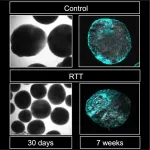New insights into the assembly of photosynthetic membranes
2021-07-02
(Press-News.org) An international study has elucidated the structure of a protein that is required for the assembly and stability of photosynthetic membranes.
Plants, algae and cyanobacteria convert carbon dioxide and water into biomass and oxygen with the aid of photosynthesis. This process forms the basis of most forms of life on Earth. Global warming is exposing photosynthetic organisms to increasing levels of stress. This reduces growth rates, and in the longer term presents a threat to food supplies for human populations. An international project, in which Ludwig-Maximilians-Universitaet (LMU) in Munich biologist Kärin Nickelsen and his research group played a significant role, has now determined the three-dimensional structure of a protein involved in the formation and maintenance of the membranes in which photosynthesis takes place. The insights provided by the study will facilitate biotechnological efforts to boost the ability of plants to cope with environmental stresses.
The initial steps in photosynthesis take place within the 'thylakoid' membranes, which harbor pigment-protein complexes that absorb energy from sunlight. It has been known for decades that, in virtually all photosynthetic organisms, a protein called VIPP1 (which stands for 'vesicle-inducing protein in plastids') is indispensable for the assembly of thylakoids. "However, how VIPP1 actually performs this essential function has remained enigmatic up to now," says Steffen Heinz, a postdoc in Nickelsen's group and joint first author of the new publication. Thanks to the new study, which was led by the Helmholtz Zentrum München, researchers now know a great deal more.
Assembly of photosynthetic membranes
The team used cryo-electron microscopy to determine the three-dimensional structure of VIPP1 at high resolution. Analysis of this structure, in combination with functional investigation of the protein's mode of action, demonstrated how small numbers of VIPP1 molecules form short strands, which are interwoven to form a basket-like structure. This then serves as a scaffold for the assembly of the thylakoid membrane, and determines its curvature. Using a related technique known as cryo-electron tomography, the scientists were also able to image VIPP1 membranes in their natural state in algal cells. By introducing site-specific mutations into VIPP1, they showed that the interaction of VIPP1 with thylakoid membranes is vital for the maintenance of their structural integrity under high levels of light stress. This finding demonstrates that the protein not only mediates the assembly of thylakoids, but also plays a role in enabling them to adapt to environmental fluctuations.
The results provide the basis for a better understanding of the mechanisms that underlie the formation and stabilization of thylakoids. They will also open up new opportunities to enhance the ability of green plants to withstand extreme environmental stresses.
INFORMATION:
ELSE PRESS RELEASES FROM THIS DATE:
2021-07-02
Researchers based in Munich and Tuebingen have developed an open-source camera system that images natural habitats as they appear to rodents.
During the course of evolution, animals have adapted to the particular demands of their local environments in ways that increased their chances of survival and reproduction. This is also true of diverse aspects of the sensory systems that enable species to perceive their surroundings. In the case of the visual system, these adaptations have shaped features such as the positioning of the eyes and the relative acuity of different regions of the retina.
However, our knowledge of the functional evolution of visual systems in mammals has remained relatively sparse. "In the past 10 or 15 years, the mouse has become the favored model ...
2021-07-02
Elisa Cordero, a doctor at the Virgen del Rocío University Hospital, researcher at the Institute of Biomedicine of Seville (IBiS) and professor in the Department of Medicine at the University of Seville, led a study involving researchers from 12 Spanish hospitals to study the clinical characteristics and facilitate the prognosis of solid organ transplant recipients with COVID-19.
The study provides a more precise description of the complications caused by Covid-19 in organ transplant recipients and has provided useful clinical indicators to identify the disease early. This makes it possible to determine therapeutic and care measures ...
2021-07-02
There are plenty of negatives associated with smart technology -- tech neck, texting and driving, blue light rays -- but there is also a positive: the digital age is not making us stupid, says University of Cincinnati social/behavioral expert Anthony Chemero.
"Despite the headlines, there is no scientific evidence that shows that smartphones and digital technology harm our biological cognitive abilities," says the UC professor of philosophy and psychology who recently co-authored a paper stating such in Nature Human Behaviour.
In the paper, Chemero and colleagues at the University of Toronto's Rotman School of ...
2021-07-02
A new study disputes the prevailing hypothesis on why Mercury has a big core relative to its mantle (the layer between a planet's core and crust). For decades, scientists argued that hit-and-run collisions with other bodies during the formation of our solar system blew away much of Mercury's rocky mantle and left the big, dense, metal core inside. But new research reveals that collisions are not to blame--the sun's magnetism is.
William McDonough, a professor of geology at the University of Maryland, and Takashi Yoshizaki from Tohoku University developed a model showing ...
2021-07-02
Ibaraki, Japan - The flavor of a tomato is an interaction between its taste and aroma. Now, researchers from Japan and the United States have revealed that the pigments that determine the colors of tomatoes also affect their flavor.
In a study published this month, researchers from University of Tsukuba developed a new method to rapidly measure the pigment profiles of tomatoes and used the technique to explore how pigments affect the taste and aroma of different tomato varieties.
The color of tomatoes is produced by combinations of different types of pigments, including carotenoids and chlorophylls. These pigments can also affect the accumulation of flavor-related compounds such as sugars, which affect the taste of tomatoes, and volatile ...
2021-07-02
A surprising study by UNSW on the behaviour of unrelated lizards in very different parts of the world has demonstrated how evolution can lead to different species learning the same skills.
The study in Ecology Letters documents how the Anolis lizard species in the Caribbean, and the Draco lizard species in Southeast Asia, have solved the challenge of communicating with one another to defend territories and attract mates.
It found males from both species perform elaborate head bob and push up displays, and rapidly extend and retract their often large and conspicuously coloured dewlap, or ...
2021-07-02
The muskrat, a stocky brown rodent the size of a Chihuahua - with a tail like a mouse, teeth like a beaver and an exceptional ability to bounce back from rapid die-offs - has lived for thousands of years in one of Earth's largest freshwater deltas, in northeastern Alberta, Canada.
Today, this delta lies within one of the largest swaths of protected land in North America: a national park five times the size of Yellowstone that's home to the planet's biggest herd of free-roaming bison and the last natural nesting ground for the endangered whooping crane. It's also central to the culture ...
2021-07-02
Guadalupe fur seals (Arctocephalus townsendi) have established a large resting colony in the Gulf of California--bringing the total number of sites where this endangered species now occurs to just four. This new haul-out was discovered on El Farallón de San Ignacio Island, along the mainland coast of Mexico, according to researchers from Mexico and the University of British Columbia.
Guadalupe fur seals were hunted for their furs and declared extinct in the late 1800's. However, 14 individuals were discovered on Guadalupe Island in 1950--and the population has grown since then. While still designated as vulnerable to extinction, according to IUCN, the population is believed to total 41,000 individuals and is growing ...
2021-07-02
In an Australian world-first, researchers have successfully repurposed two existing medications to reduce the severity of sleep apnoea in people by at least 30 per cent.
Affecting millions around the world, sleep apnoea is a condition where the upper airway from the back of the nose to the throat closes repetitively during sleep, restricting oxygen intake and causing people to wake as often as 100 times or more per hour.
Those with untreated sleep apnoea are more likely to develop cardiovascular disease, dementia and depression, and are two to four times more likely to crash a car than the general population.
Despite almost thirty years of research, there are no approved drug therapies to treat the condition.
Professor Danny Eckert, Principal ...
2021-07-02
Fukuoka, Japan--Medical researchers led by Kyushu University have revealed a possible underlying genetic pathway behind the neurological dysfunction of Rett syndrome. The team found that deficiencies in key genes involved in the pathology triggers neural stem cells to generate less neurons by producing more astrocytes--the brain's maintenance cells.
The researchers hope that the molecular pathology they identified, as reported in the journal Cell Reports, can lead to potential therapeutic targets for Rett syndrome in the future.
Rett syndrome is a progressive neurodevelopmental disorder characterized by impairments in cognition and coordination--with varying severity--and occurs in roughly one in every 10,000 to 15,000 female births. However, it ...
LAST 30 PRESS RELEASES:
[Press-News.org] New insights into the assembly of photosynthetic membranes




